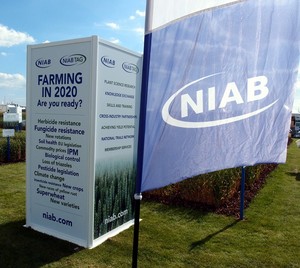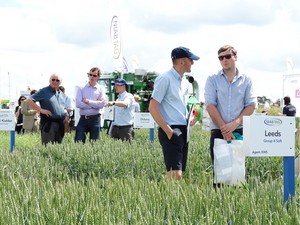- About
-
Research
- Agronomy and farming systems
-
Agricultural crop research
-
Research projects - agriculture
- About SASSA-SAI
- BioBoost
- Biomass Connect
- CTP for Sustainable Agricultural Innovation
- Climate Ready Beans - workshop presentations (March 2022)
- Crop diversity HPC cluster
- Designing Future Wheat
- Final project workshop
- Get involved
- List of materials
- News and updates
- Partners
- Rustwatch
- The Sentinel Crop Disease Surveillance Network
- The research team
- UK Cereal Pathogen Virulence Survey
- UK wheat varieties pedigree
- Weed management - IWM Praise
- Crop breeding
- Crop characterisation
- Data sciences
- Genetics and pre-breeding
- Plant biotechnology
- Plant pathology and entomology
- Resources
-
Research projects - agriculture
-
Horticultural crop research
-
Research projects - horticulture
- Augmented Berry Vision
- BEESPOKE
- Boosting brassica nutrition in smart growing systems
- CTP for Fruit Crop Research
- Develop user-friendly nutrient demand models
- Egg laying deterrents for spotted wing drosophila
- Enhancing the nutritional quality of tomatoes
- Improving berry harvest forecasts and productivity
- Improving vineyard soil health through groundcover management
- Intelligent growing systems
- Knowledge transfer for sustainable water use
- POME: Precision Orchard Management for Environment
- RASCAL
- STOP-SPOT
- UV-Robot
- Crop science and production systems
- Genetics, genomics and breeding
- Pest and pathogen ecology
- Field vegetables and salad crops
- Plum Demonstration Centre
- The WET Centre
- Viticulture and Oenology
-
Research projects - horticulture
- Crop Science Centre
-
Services
- Analytical Services
- Business Development
- Commercial trial services
- Membership
- Plant breeding
- Plant characterisation
- Seed certification
-
Training
-
Technical agronomy training
- Advanced crop management of bulb onions
- Advanced crop management of vegetable brassicas
- Advanced nutrient management for combinable crops
- Benefits of cover crops in arable systems
- Best practice agronomy for cereals and oilseed rape
- Developing a Successful Strategy for Spring Crops
- Disease Management and Control in Cereal Crops
- Incorporating SFI options into your rotation
- Protected Environment Horticulture – Best Practice
- Techniques for better pest management in combinable crops
- Crop inspector and seed certification
- Licensed seed sampling
-
Technical agronomy training
- News & Views
- Events
-
Knowledge Hub
- Alternative and break crops
-
Crop genetics
- POSTER: Diversity enriched wheat (2025)
- POSTER: Genetics of wheat flag leaf size (2024)
- POSTER: Wheat yield stability (2024)
- Poster: Traits for future cereal crops (2022)
- POSTER: wild wheat fragment lines (2022)
- POSTER: Improving phenotyping in crop research (2022)
- PRESENTATION: Plant breeding for regen ag
- Poster: Designing Future Wheat (2020)
- Crop nutrition
-
Crop protection
- POSTER: Understanding the hierarchy of black-grass control (2025)
- POSTER: Emerging weed threats (2025)
- POSTER: Disease control in barley (2025)
- Poster: Weed seed predation in regen-ag (2024)
- POSTER: Disease control in winter wheat (2025)
- POSTER: Mode of action (2023)
- POSTER: Inter-row cultivation for black-grass control (2022)
- POSTER: UKCPVS winter wheat yellow rust in spring 2025 (2025)
- Poster: Management of Italian ryegrass (2021)
- POSTER: UKCPVS winter wheat rusts - 2024/25 review (2025)
- POSTER: UKCPVS disease monitoring and the benefit to UK growers (2025)
- POSTER: Diagnosing and scoring crop disease using AI (2025)
- POSTER: Finding new sources of Septoria resistance (2024)
- POSTER: Fungicide resistance research (2024)
- POSTER: Detecting air-borne pathogens (2024)
- POSTER: Oilseed rape diseases (2024)
- POSTER: Fungicide resistance research (2024)
- POSTER: Improving chocolate spot resistance (2022)
- Poster: Pathogen diagnostics (2022)
- Fruit
- Regen-ag & sustainability
-
Seed certification
- POSTER: Wheat DUS (2024)
- POSTER: Innovation in variety testing (2024)
- POSTER: AI and molecular markers for soft fruit (2024)
- POSTER: Barley crop identification (2023)
- POSTER: Herbage grass crop identification (2023)
- POSTER: Herbage legume crop identification (2024)
- POSTER: Minor cereal crop inspecting (2023)
- POSTER: Pulse crop identification (2023)
- POSTER: Wheat crop identification (2023)
-
Soils and farming systems
- POSTER: Checking soil health - across space and time (2024)
- POSTER: Checking soil health - step by step (2024)
- POSTERS: Changing soil management practices (2022)
- Poster: Monitoring natural enemies & pollinators (2021)
- POSTER: Soil structure and organic matter (2024)
- POSTER: Novel wheat genotypes for regen-ag (2024)
- Video: New Farming Systems project (2021)
- Video: Saxmundham Experimental Site (2021)
- POSTER: Impact of prolonged rainfall on soil structure (2024)
- POSTER: Soil & agronomic monitoring study (2024)
- POSTER: The impact of rotations & cultivations (2024)
- VIDEO: Great Soils; soil sampling guidelines (2020)
- Poster: Soil invertebrates within arable rotations (2024)
- VIDEO: Soil health assessment (2021)
- POSTER: Saxmundham - modern P management learnings
- POSTER: Saxmundham - 125 years of phosphorus management
- Poster: Soil phosphorus - availability, uptake and management (2025)
- POSTER: Morley long term experiments (2025)
- POSTER: Exploiting novel wheat genotypes for regen-ag (2025)
- Video: Saxmundham Experimental Site (2021)
- Varieties
NEWS: NIAB TAG at Cereals 2015. Farming in 2020 – are you ready?
Stand summary (find us at stand 612)

The latest independent advice and research on plant breeding, varieties, crop agronomy, soils and plant innovation – covering everything a visitor to Cereals 2015 is looking for, including:
- winter wheat and winter oilseed rape variety demonstration plots;
- advice on cover crops including crop choice, agronomy and management;
- plant disease research and new diagnostic techniques in oilseed rape, oats and field beans;
- the latest developments on yellow rust with the UKCPVS team;
- how wheat pre-breeding research is increasing diversity and improving yields, including superwheat, tetraploids and MAGIC wheat lines;
- using crops to improve human and livestock health and nutrition, including ahi-flower, quinoa, borage and sainfoin, with NIAB Innovation Farm;
- championing the role of independent agronomic research and advice in UK agriculture with expertise in crop protection and nutrition; farming systems; plant pathology research; spray application research; soils and cultivation and variety evaluation and management;
- Do you think you know it all? Test your crop production skills and knowledge with ARTIS and check out the range of training courses;
- the Hole Story with advice on soil management, rotations, cultivations and fertility building.
Cover crops
NIAB TAG is showcasing the benefits, selection and management of cover crops at the 2015 Cereals Event. Plots of phacelia, oats and vetch, crimson clover, medick and radish will feature alongside guidance to improve the effectiveness of cover cropping strategies.
“Cover crops can count towards CAP greening measures so there is significant interest in the subject, particularly in how to make a return on investment,” says NIAB TAG’s farming systems specialist Ron Stobart. “NIAB TAG research over the past decade has shown the benefits of cover crops include increased soil organic matter and soil biodiversity, protecting the soil surface from rainfall erosion, reducing nitrate leaching, improved soil structure and enhancing wildlife and the environment.”
The cover crops exhibit is part of NIAB TAG’s ‘Farming in 2020’ theme, addressing issues such as pesticide resistance, yield plateau, loss of ag-chem chemistry, new disease races, changes in EU legislation and climate change. Alongside the popular variety demonstration plots of winter wheat and winter oilseed, visitors will also have access to herbage grass, spring beans, winter oats, ahi-flower, quinoa, borage and sainfoin.
With nearly 90 different crop and variety plots our stand is demonstrating current and potential approaches and solutions to managing these issues on farm. We will be talking about our soils, rotations and cultivations work, cereal fungicide programme options under tightened EU regulations, disease diagnostics, grass-weed control, new crops, and advances in wheat pre-breeding research,” says NIAB Technical Director Bill Clark.
Research and innovation
The AgriTech Innovation Centre area highlights the science behind the technology with a selection of NIAB’s world-class applied and translational research that could end up in wheat varieties grown on farm by 2020.
“It’s all about increasing the genetic diversity of our wheat breeding programmes, finding new sources of yield improvement, drought tolerance, disease resistance and input use efficiency,” says plant breeding programme leader Dr Phil Howell.
Each step of the superwheat breeding programme is on view, including early generations and advanced lines. NIAB is also crossing tetraploid wheats, such as wild emmer, durum and cultivated emmer, with modern varieties to bring in further diversity, with plots of the new material available.
“As well as exploiting ancestral wheat species to increase genetic diversity NIAB is also showing the ‘Multi-parent Advanced Generation Inter-Cross’ MAGIC crossing programmes. Instead of crossing the traditional two wheat varieties MAGIC uses multiple parents, mixing up the genes much more than in a normal crossing. NIAB’s original ‘elite’ 8-parent MAGIC population has shuffled the pack so much it has produced yellow rust resistant lines from susceptible parents. The ‘diverse’ MAGIC wheat has 16 varieties as parents, sampling 60 years of wheat breeding,” explains Dr Howell.
Plant pathology
Yellow rust remains the most talked about cereal disease in the UK. The UKCPVS (UK Cereal Pathogen Virulence Survey) team at NIAB will explain how surveillance and diagnostic tools are being developed to improve, and speed up, the identification of new races, with the latest advice and information on the ‘Warrior type’ yellow rust.
NIAB’s pathology plots also feature research into Verticillium in oilseed rape, oat crown rust and improving disease resistance in field beans. “Some oilseed rape varieties exhibit partial resistance to the soil-borne pathogen Verticillium longisporum, and with no current agrochemical control measures for this disease, even partial variety resistance will be important in helping to mitigate against its effects. We will be demonstrating how new diagnostic techniques for assaying Verticillium in soil, coupled with variety selection, will help to formulate an integrated approach for control,” says plant pathologist Dr Tom Wood.
Soils and varieties
Soil specialists Nathan Morris, Mark Stalham and Chris Winney will be in the soil pit, digging around the tines of a subsoiler pulled through a plot of wheat to demonstrate the importance of maintaining a healthy soil and the methods farmers can adopt to influence soil structure to ensure optimum crop yields.
The demonstration plots include 15 winter oilseed rape varieties with Simon Kightley advising on variety choice for oilseed rape, linseed, peas and beans, and Clare Leaman providing expert advice on winter wheat variety choice for 2015 with thirty established and new varieties. Simon and Clare will be supported on the variety demonstration plots by other NIAB specialists and TAG-Consulting agronomists.
Other exhibits available on the NIAB TAG stand include:
- How good are your crop production skills? ARTIS is challenging growers to test their wheat disease ID skills, black-grass management and cover crops knowledge. Find out more about the full range of field, classroom and e-learning training courses available, covering crop husbandry, technologies and regulatory or economic issues that impact on crop production;
- NIAB Innovation Farm highlights and promotes developments and innovation in plant genetics, and this year features crops with traits to improve human and livestock health and nutrition including ahi-flower, quinoa, borage and sainfoin;
- Sustainable Intensification Research Platform, known as SIP, a £2 million Defra-funded research project led by NIAB identifying the most effective practices and testing potential new farming systems to increase farm productivity while reducing environmental impacts and enhancing ecosystem services.
- NIAB TAG Network membership services including the latest crop production advice and farmer-led research, field days, agronomy trials results, unique regional variety information and weekly agronomy updates through the season;
Find us at stand 612







